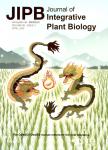Monitoring the Expression of Maize Genes in Developing Kernels under Droug ht Stress usingOligo-microarray
Monitoring the Expression of Maize Genes in Developing Kernels under Drought Stress using Oligo-microarray作者机构:The University of Georgia Department of Crop and Soil Sciences Tifton GA 31793 USA J. Craig Venter Institute Rockville MD 20850 USA US D-epartment of Agriculture Agricultural Research Service Crop Protection and Management Research Unit Tifton GA 31793 USA
出 版 物:《Journal of Integrative Plant Biology》 (植物学报(英文版))
年 卷 期:2010年第52卷第12期
页 面:1059-1074页
核心收录:
学科分类:0710[理学-生物学] 07[理学] 08[工学] 09[农学] 071007[理学-遗传学] 0901[农学-作物学] 0703[理学-化学] 0902[农学-园艺学] 0836[工学-生物工程] 090102[农学-作物遗传育种]
基 金:supported by USDA Specific Cooperative Agreements 58-6602-1-213 and 58-6602-6-121 with the University of Georgia supported by funds provided by the USDA Agricultural Research Service the Georgia Agricultural Commodity Commission for Corn
主 题:CORN GENETICS GENETIC regulation in plants EFFECT of drought on plants EFFECT of stress on plants DNA microarrays AFLATOXINS CROPS -- Postharvest technology
摘 要:Preharvest aflatoxin contamination of grain grown on the US southeastern Coast Plain is provoked and aggravated by abiotic stress. The primary abiotic stress is drought along with high temperatures. The objectives of the present study were to monitor gene expression in developing kernels in response to drought stress and to identify drought-responsive genes for possible use in germplasm assessment. The maize breeding line Tex6 was used, and gene expression profiles were analyzed in developing kernels under drought stress verses well-watered conditions at the stages of 25, 30, 35, 40, 45 d after pollination (DAP) using the 70 mer maize oligo-arrays. A total of 9 573 positive array spots were detected with unique gene IDs, and 7 988 were common in both stressed and well-watered samples. Expression patterns of some genes in several stress response-associated pathways, including abscisic acid, jasmonic acid and phenylalanine ammonia-lyase, were examined, and these specific genes were responsive to drought stress positively. Real-time quantitative polymerase chain reaction validated microarray expression data. The comparison between Tex6 and B73 revealed that there were significant differences in specific gene expression, patterns and levels. Several defense-related genes had been downregulated, even though some defense-related or drought responsive genes were upregulated at the later stages.



